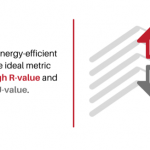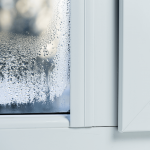What type of window is the most energy-efficient? How to read U-values and R-values to tell.
Window energy efficiency is measured by two metrics: U-value and R-value. Both values are indicators of window performance, and for windows to be as energy-efficient as possible, you’ll want to pay attention to both of these numbers.
- U-value measures heat transfer, or heat gain or loss through the glass. U-value is not a material rating; it is a calculation of the efficiency of the entire window assembly, all the various materials and substrates used in the construction of the window
- R-value measures the performance of a specific material, such as insulation, based on the material’s ability to reduce the transfer of heat.
For example, according to the US Energy Department, a good R-value range is greater than R-5, and a good U-value range is between 0.20 and 1.20.
Why does R-Value Matter?
R-value is important because it can indicate how well a window can block airflow in or out. A higher R-value, meaning the more it can resist airflow, is based on the number of panes in the glass, the type of window frame, and the size of the window.
For a high R-value, look for windows with more panes and larger air space between the panes, such as triple-pane insulated glass Revelation Elite Windows from LEI Home Enhancements. In addition to highly efficient triple-pane glass, these high-quality replacement windows feature a Warm-Edge Spacer System: two airspaces filled with argon gas and two surfaces of low-emissivity (Low-E) glass. Low-E glass has a thin, transparent coating that reflects heat without blocking natural light – it also raises R-value.
A window with a higher R-value helps:
- Lower energy consumption in the home
- Reduced solar heat gain
- Maintain consistent temperature
Why does U-Value Matter?
U-value is a calculation of the overall efficiency of the materials that make up a window. It measures insulating ability and informs how much energy can pass through one square foot of material. This number is particularly important in places with extreme temperatures – you want a window with a low U-value if you live in a cold climate to best prevent frigid air from seeping into your home.
The Key Takeaway
When it comes to reading and understanding replacement window specs, a simple way to evaluate the most energy-efficient windows is to look for a high R-value and a low U-value.
When you’re ready to upgrade the windows in your home, and need help finding the right balance of energy efficiency and affordability, give the professionals at LEI Home Enhancements a call. Contact the team at LEI for a free consultation today.
Sharing is caring!





